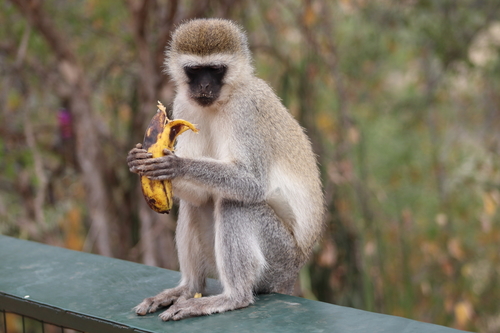
Vervet Monkey
The vervet monkey (Chlorocebus pygerythrus) thrives in Africa's diverse landscapes, from savannas to woodlands. Known for their striking black faces and grey bodies, these social primates exhibit complex vocalizations, reflecting their dynamic social structures. Their adaptability enriches ecosystems by aiding seed dispersal and pest control.
12-24 years
Lifespan
3.5 - 5.0 kg
Weight
Length: 46 - 66 cm
Size
Brown, Grey, Black, Silver, Olive
Color
2-5 years
Age of Sexual Maturity
8-12 months
Age of Weaning
30 mph
Top Speed
Least Concern
Conservation Status
Decreasing
Population Trend
Characteristics
Chlorocebus pygerythrus, commonly known as the vervet monkey, inhabits savannas, woodlands, and mountains across Eastern and Southern Africa. These social primates are known for their distinctively colored fur, with grey bodies, black faces, and a characteristic blue scrotum in males. They are highly adaptable, often seen in troops, and possess complex vocal communication systems.
Distribution Range of the Vervet Monkey
The Vervet Monkey (Chlorocebus pygerythrus) is native to sub-Saharan Africa. Its geographical distribution includes eastern and southern Africa, with populations found in countries such as Ethiopia, Kenya, Tanzania, Uganda, Rwanda, Burundi, Malawi, Zambia, Mozambique, Zimbabwe, Botswana, Namibia, and South Africa.
Vervet Monkey's Habitat
Environmental Conditions
Vervet Monkeys inhabit a variety of environments, primarily favoring savanna, riverine woodland, coastal forest, and mountainous regions. They are adaptable to different climates, ranging from humid to arid conditions. The presence of water sources is crucial, often found near rivers or streams.
Ecological Niche
As an arboreal and terrestrial species, Vervet Monkeys play a significant role in their ecosystem as seed dispersers and prey for larger predators. They have a varied diet that includes fruits, leaves, seeds, flowers, and insects, allowing them to thrive in diverse habitats. Their adaptability to human-modified landscapes, such as agricultural areas, also highlights their ecological flexibility.
Copyright @ Nature Style Limited. All Rights Reserved.
 English
English